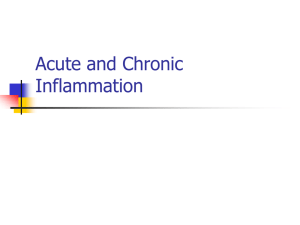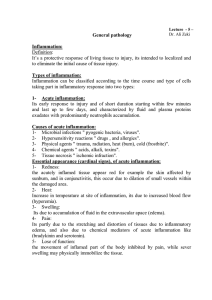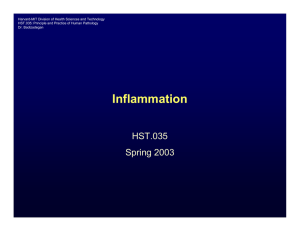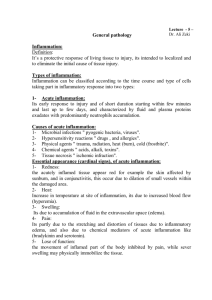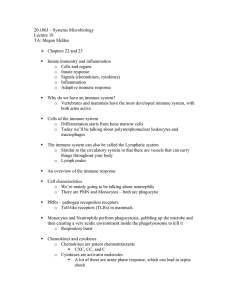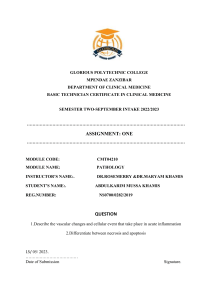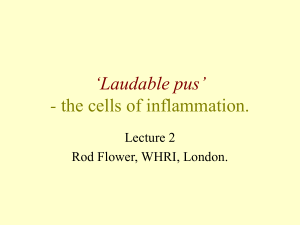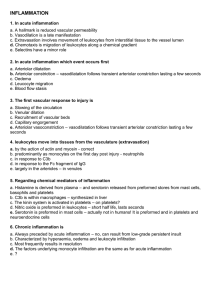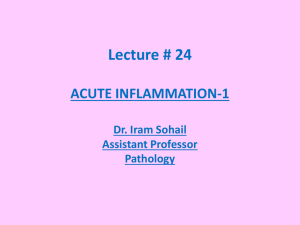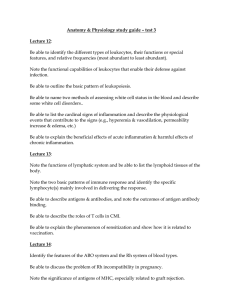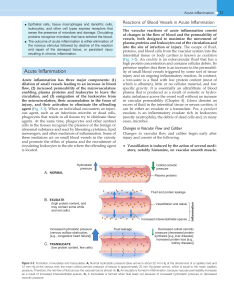acute inflammation -2
advertisement
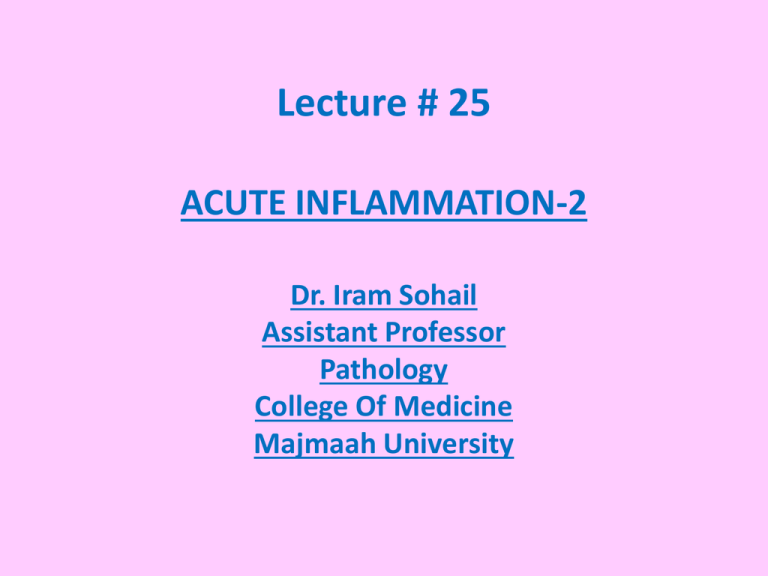
Lecture # 25 ACUTE INFLAMMATION-2 Dr. Iram Sohail Assistant Professor Pathology College Of Medicine Majmaah University OBJECTIVES • Discuss the mechanism of acute inflammation • Enlist the features of acute inflammation MECHANISM OF ACUTE INFLAMMATION • Acute inflammation is a rapid response to injury, microbes or foreign body that is designed to deliver leukocytes and plasma proteins to the site of injury for the clearance of microbes and getting rid of necrotic tissue. Acute inflammation has 2 main components 1. Vascular changes – Vasodilation – Increased vascular permeability 2. Cellular events 1. Vascular changes A. Changes in vascular caliber i. Transient vasoconstriction ii. Vasodilation – Resulting in increased blood flow to the site of injury for delivering more fluid and leukocytes. This is the cause of warmth and redness which we noticed at the site of acute inflammation. B. Increased vascular permeability To deliver the WBCs & fluid at the site of injury This fluid will be transudate or exudate. Transudate • Ultra filtrate of plasma composed of more fluid and less protein. Exudate • Protein & cells rich fluid • Several mechanisms may contribute to increased vascular permeability – Endothelial cell contraction – Endothelial injury – Leakage from new blood vessels (Fluid leakage results in edema) 2. Cellular events • An important function of inflammatory response to deliver leukocytes at the site of injury and then these leukocytes will kill bacteria and eliminate necrotic tissue. Cellular events – Emigration of WBCs from circulation to the site of injury. • The principle leukocyte (WBC) in acute inflammation is neutrophil. i. Leukocyte recruitment Margination – Leukocyte accumulation at periphery of vessels Rolling – Leukocytes roll & stick to endothelial cells Adhesion to endothelium – With the help of following adhesion molecules Endothelial Molecule Leukocyte Molecule Major Role P-selectin Sialyl-Lewis X-modified proteins Rolling (neutrophils, monocytes, lymphocytes) E-selectin Sialyl-Lewis X-modified proteins Rolling and adhesion (neutrophils, monocytes, T lymphocytes) GlyCam-1, CD34 L-selectin Rolling (neutrophils, monocytes)* ICAM-1 (immunoglobulin family) CD11/CD18 integrins (LFA-1, Mac-1) Adhesion, arrest, transmigration (neutrophils, monocytes, lymphocytes) VCAM-1 (immunoglobulin family) VLA-4 integrin Adhesion (eosinophils, monocytes, lymphocytes) CD31 CD31 Transmigration (all leukocytes) Transmigration between endothelial cells – Transmigration of leukocytes by squeezing between cells at intercellular junctions (diapedesis) Chemotaxis – Leukocytes migrate towards site of injury or infection with the help of chemotactic agents (cytokines, chemokines, complements) ii. Leukocyte activation – These leukocytes first activated by different stimuli. – Then killing of bacteria/particle occurs by the process of phagocytosis. Phagocytosis • It is a process by which leukocytes engulf & destroy bacteria/particle. • 3 steps I. Recognition and attachment of particle with leukocyte (opsonization) II. Engulfment of particle • Pseudopods extend around the object and form a phagocytic vacuole; this will fuse with lysosome and forms a phagolysosome III. Killing & degradation of ingested material • Lysosomal enzymes & reactive oxygen species (super oxide, hydrogen peroxide) will kill the microbe. FEATURES OF ACUTE INFLAMMATION There are 5 cardinal signs/ features of acute inflammation. 1. Calor (Heat) 2. Rubor (redness) 3. Tumor (swelling) 4. Dolor (pain) 5. Functio laesa (loss of function) End results (outcome) of Acute Inflammation 1. Resolution • complete return to normal of tissue if injury is eliminated 2. Tissue destruction and persistent of inflammation 3. Progression to chronic inflammation 4. Healing by fibrosis (scar formation)
